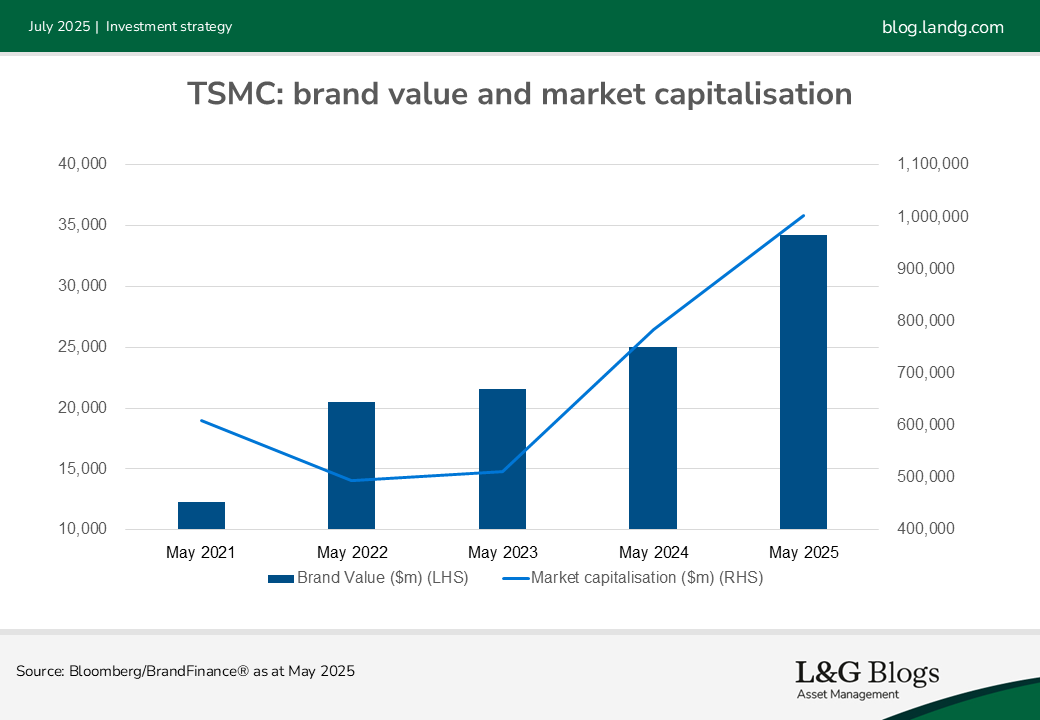Disclaimer: Views in this blog do not promote, and are not directly connected to any L&G product or service. Views are from a range of L&G investment professionals, may be specific to an author’s particular investment region or desk, and do not necessarily reflect the views of L&G. For investment professionals only.
Spotlight on the world’s strongest brands: TSMC
In this blog series, we focus on three leading global companies, showing how a strong brand can contribute to financial performance across a range of sectors. First up is chipmaker TSMC*.

Asked to think about the world’s biggest brands, many will instinctively think of luxury or consumer goods. But a strong brand is a significant asset for any company, regardless of the sector in which it operates.
To kick off this series of blogs looking at the world’s leading brands, we’ve chosen Taiwanese semiconductor contract manufacturing and design company TSMC.
Let’s take a look at TSMC’s business model, its latest financial results and the monetary value of its brand.
TSMC: the engine of global semiconductor manufacturing
TSMC manufactures semiconductors and is the main supplier for tech industry giants such as Nvidia*, Apple* and AMD*.
The company has a pure-play foundry business model. Its chips are designed by other companies, but it focuses on developing the best and most efficient processes for making them. Its unparalleled expertise, strong leadership and first-mover advantage have given TSMC a dominant share (over 60%[1]) in the global chip foundry market, putting the company at the epicentre of the semiconductor world.
AI-driven growth, margin strength and solid outlook
Playing a major role in meeting the rising global demand for chips, TSMC is benefitting from the relentless evolution of AI and resilient AI demand. This was reflected in the latest company guidance and results.
Gross margins remain on track to surpass 2024’s 56%, and net margin expected to increase to 42%, reflecting operational efficiency and pricing power.[2]
At its latest results announcement, TSMC re-affirmed its mid-20% revenue growth target for 2025 and the coming years.
Quarter-on-quarter, sales rose 41.6% and revenues rose 60.2%, with year-on-year rises of 33.9% and 39.9%, respectively, surpassing analyst expectations, and driven by High Performance Computing (HPC) powered by surging demand for AI data-centre chips.
What is the TSMC brand worth?
BrandFinance® has estimated TSMC’s brand value at $34.2 billion in 2025.[3] This is the economic benefit that the brand contributes to the business.
BrandFinance® is the leading name in independent brand valuation and the first consultancy certified to provide ISO-compliant brand valuation and evaluation. Their assessments are based primarily on quantitative analysis, while also being informed by market research, financial data and market indicators of brand health.
In BrandFinance®’s Semiconductor 30 2025 publication, TSMC reported a 37% increase in brand value, maintaining its second-place position after Nvidia, and earned an AA+ rating[4], the highest in the semiconductor sector.
As shown below, TSMC’s brand value has consistently risen since 2021, while its market capitalisation declined in 2022, in line with global technology stocks, before rallying strongly over the past couple of years.

Sustainability in focus
The widespread deployment of AI has raised concerns about the potential environmental impact of the underlying infrastructure.
However, as we have stated previously, as well as being essential to so many of our everyday activities, we believe the infrastructure underpinning digitalisation is critical to key societal goals such as increased financial inclusion and creating a more environmentally sustainable world. TSMC has stated that all its chips are energy-efficient, low-power and energy star certified.[5]
By 2030, TSMC aims to reduce water consumption by 30% from the 2010 base year, increase the replacement rate of regenerated water by more than 30%, and reduce water pollution.
What impact could US tariffs have on TSMC?
Although semiconductors are not currently in scope of US tariffs, TSMC could be impacted by softened demand if key customers such as Nvidia opted to delay launches.
However, continued demand for AI looks set to remain as a strong structural driver, potentially allowing TSMC to raise prices – we believe this could more than outweigh the impact of tariffs.
At the TSMC Tech Symposium in April, the company noted that semiconductor revenue could hit $1 trillion by 2030, with high performance computing and AI accounting for nearly 50% of this.
Additionally, to hedge for US risks, in 2020, TSMC chose Phoenix, Arizona, as the site for its first US manufacturing facility, and to date it has invested $165 billion in several processing technologies at the site – representing the largest foreign direct investment in a greenfield project in American history.[6]
Other risks to consider
In addition to uncertainty around US tariffs, TSMC could be exposed to competition risk from Intel, which, as a US-based company, may be facilitated by the CHIPS Act, although TSMC maintains its large market share.
Another potential concern is unfavourable FX moves. The trend of a weaker US dollar that has been in evidence so far in 2025 is unhelpful for TSMC, as it sells primarily in dollars.
Overall, however, we see many supportive factors in place for TSMC’s outlook – not least the strength of its global brand.
Our next blog will consider how another high-tech industry leader – Deutsche Telekom – is capitalising on both AI momentum and the power of a globally recognised brand.
*For illustrative purposes only. Reference to a particular security is on a historic basis and does not mean that the security is currently held or will be held within an L&G portfolio. The above information does not constitute a recommendation to buy or sell any security.
[1] Source: https://www.nasdaq.com/articles/1-number-may-ensure-tsmcs-market-dominance
[2] Source: TSMC Q1 2025 results presentation.
[3] Source: BrandFinance® as at June 2025.
[4] These ratings are derived from the Brand Strength Index which benchmarks the strength, risk and future potential of a brand relative to its competitors on a scale ranging from D to AAA. It is conceptually similar to a credit rating. Source: BrandFinance®.
[5] Source: Sustainalytics, TSMC as at June 2025.
[6] Source: TSMC Arizona - Taiwan Semiconductor Manufacturing Company Limited
Recommended content for you
Learn more about our business
We are one of the world's largest asset managers, with capabilities across asset classes to meet our clients' objectives and a longstanding commitment to responsible investing.

